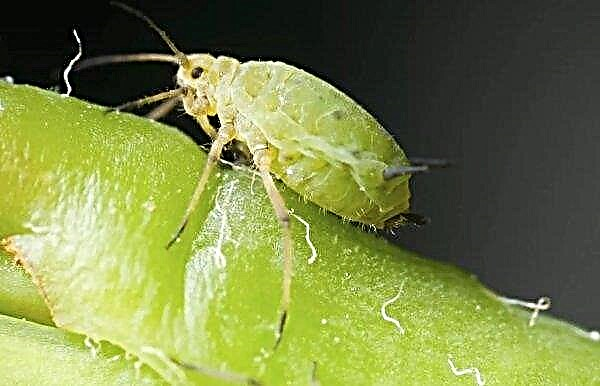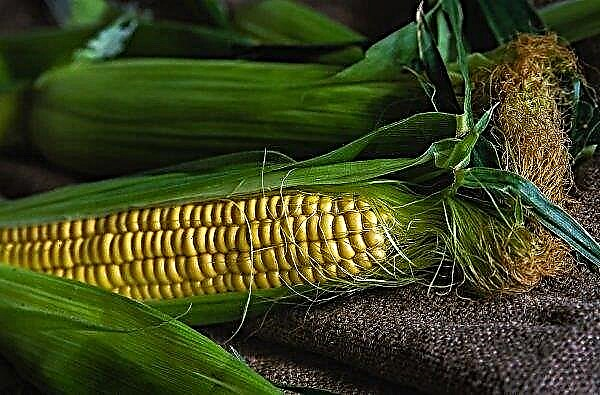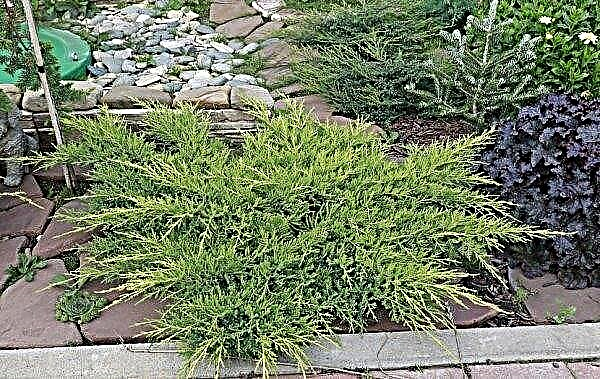Without exception, all lovers of home flowers know the name "ficus", but few people know how varied the varieties of this plant are. Many of them grow in the tropics, reaching the height of a whole tree, however at home you can often find Benjamin Kinki ficus. It is about this form and its features that will be discussed later.
Botanical description of the plant
Kinki belongs to one of the varieties of the famous ficus Benjamin, this is the most common representative at home of this plant. The flower is native to the rainforests of Africa and Australia.
The plant of the mulberry family is a dwarf shrub with tree stems and dense, variegated, smooth foliage. Due to the small distance between the leaves (2 cm), the crown acquires a spherical fluffy shape. The stalk of the flower is straight, the shoots are falling.Did you know? A popular sign says that a childless couple who wants to have a child must necessarily grow ficus in the house, then their desire will certainly come true.
Ficus blooms occur mainly only in natural conditions, indoor varieties, including Kinki, bloom extremely rarely. At the base of the leaves a small spherical inflorescence is formed, the size of a pea, with a hole in the center for pollination by insects.
| Root system | invasive, branched, without formation of aerial roots |
| Stem | woody, straight, smooth, with brownish-gray bark |
| Leaf shape | simple, oval, oblong with a pointed end |
| Leaf color | mottled, dark green, with a light border around the edge |
| Flower color | light yellow to orange |
House growing conditions
It is not difficult to grow this plant at home, but adhere to the basic rules of maintenance.
Seat selection
A tropical flower likes conditions close to natural, therefore, when choosing a place for it, it is important to be guided by important points:
- the place must be protected from drafts and direct rays of the sun;
- the plant is placed away from central heating systems in the winter;
- Lighting should be intense, but scattered, slight shading is allowed;
- the place should be permanent, the ficus does not tolerate the change of conditions.
Temperature
Kinki is not intended for growing in the cold, it is heat-loving. The ideal temperature for its maintenance is + 22 ... + 26 ° С, in the autumn-winter period the thermometer in the room should not fall below + 15 ° С.
Did you know? Ficus is often called a rubber tree, because the plant produces white juice - latex, which is 40% rubber.
Air humidity
Like any plant from the tropics, ficus is very fond of humidified air, so it is necessary to maintain a humidity level of at least 65%.
Home Care
A relative of ficus Benjamin is unpretentious in care, and therefore has gained great popularity among flower growers.
Watering
Perhaps this is one of the most important points on which it is worth focusing the attention of a beginner grower. Ficuses are tropical plants and their relation to the moisture they consume is determined by this factor. The paradox is that Kinki love moist air, but do not tolerate waterlogging of the soil, their roots are not as developed as those of wild counterparts, so aerial roots are not formed, and those that are underground burnt very quickly when water stagnates.
You need to water the flower in moderation, strictly as the earthen coma dries up, watering is carried out by the traditional method: under the root. The water should be settled, soft, in summer the temperature of the water should be room temperature, and in winter it is better to warm it up to a temperature of + 24 ... + 25 ° С.
Important! It is recommended that Benjamin's ficus be constantly sprayed with warm water, while direct sunlight should not fall on the plant.
Top dressing
The issue of feeding this plant needs to be approached thoroughly, because due to a lack of nutrients, Kinki ficus begins to shed leaves and slow down growth. Experienced flower growers know what needs to be done to avoid this: in spring and summer, during the period of intensive growth, the soil under the flower needs to be regularly fertilized.
It is better to buy ready-made fertilizers of industrial production for indoor plants. The first dressing should be done in the spring, but not earlier than a month after the flower is transplanted into new soil. In spring and summer, nitrogen fertilizers are used (for example, “Mr. Color”), the composition is applied under the root at the same time as the next watering, every 14-15 days.
In autumn, the frequency of top dressing is gradually reduced first to 1 time per month, then for the entire autumn-winter period to 1 time in 2-3 months. In winter, complex mineral-organic fertilizers are used (for example, Reasil).
Pruning
There is no strict need for pruning a plant, but it is often produced for decorative purposes. Ficus without outside interference grows arbitrarily, which leads to stretching the stem up and reducing the density of the crown. In order to give the flower the desired look, its branches and leaves can safely be cut off as necessary and in the right amount. Kinki transfers this procedure completely painlessly.
Important! During pruning shoots and ficus leaves, it is necessary to wear rubber gloves, as the juice secreted by the flower can cause irritation and an allergic reaction!
Video: trimming and shaping the crown of a ficus kinki
Transfer
Transplantation has a beneficial effect on the condition of this plant, so it is important to follow the standard scheme:
- the first time a Kinky ficus is transplanted after purchase, since the pot for seedlings is very cramped and the substrate does not contain enough nutrients;
- the first two years the flower is transplanted once a season, in the spring;
- an adult plant is transferred to a new container as the crown and root system grows, usually every 2-3 years.
To correctly move the flower to a new habitat, you need to prepare a pot larger than the original, soil for ficus (it is better to use ready-made, for example, "Garden of Miracles": peat, sand and humus are mixed in equal parts) and drainage stones.
The process is as follows:
- A drainage layer of at least 1 cm is poured at the bottom of the new pot, then the first layer is lightly sprinkled with the soil mixture.
- The plant is carefully removed from the old container with an earthen lump so as not to damage the roots and placed in a new pot.
- The voids formed around the roots are covered with prepared soil, after which the soil is carefully watered with warm water.
Video: Ficus Kinki transplant
Breeding
Benjamin's ficus propagates, like most houseplants, by cuttings.
Guide:
- With a sharp knife or blade, cut a small stalk with several leaves from the top of the crown, place its slice in water or in a container with wet sand and put in a warm place until rooting.
- Usually, roots appear after 10-15 days. Throughout this period, the sand should be moistened with warm water and cover the seedlings with a cap from a plastic glass.
- Once the stalk is rooted, it is transplanted to a permanent place in the soil mixture for ficus.
Possible growing difficulties
Of course, when growing ficus Kinki, you can encounter some problems characteristic of this plant:
- The most common ailment is leaf fall. Most often, the situation becomes stressful for the flower: a change in habitat, a sharp drop in temperature, a transplant into an oversized pot. To avoid such a problem, you must initially choose a place convenient and suitable for the plant and not move it unnecessarily. In addition, do not too often transplant ficus in new flowerpots. If the leaves continue to fall off, it is also worth excluding the presence of drafts.

- Crown loss and yellowing may be caused by violation of the watering regime. If such symptoms appear, you need to adjust the watering so that stagnation of water in the root area is excluded, as well as to prevent complete drying of the earth in the pot.

- The appearance of white plaque on the leaves talks about the defeat of the flower by powdery mildew. To exclude the spread of the disease, the affected foliage is destroyed, and the healthy crown of the plant is treated with a fungicidal solution (for example, "Mikosan"), according to the instructions.

- Frequent guests on the leaves of the ficus are a spider mite and a scab.. If they just appeared, then for their destruction it is urgent to rinse the entire bush under a shower with very warm water, at least + 45 ° С. In advanced cases, special insecticides are used (for example, Aktara).

So, the main characteristics and features of the Kinki ficus were considered above. The foregoing allows us to conclude that this plant has good endurance, it is unpretentious in care and is ideal for home breeding even for beginner gardeners.
















